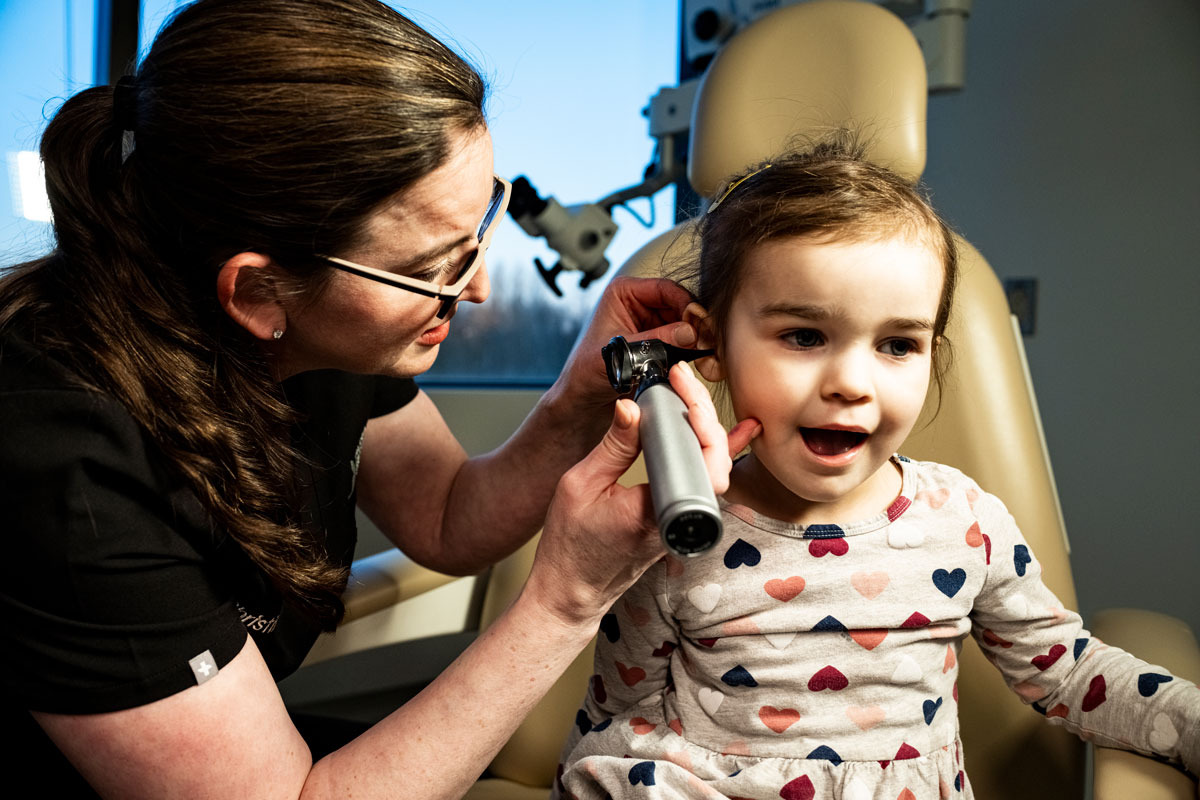Prevent chronic ear infections and restore hearing clarity with ear tubes, tiny cylinders that are surgically inserted into the eardrum to equalize pressure and drain fluid. Take the first step towards relief by scheduling a consultation with our fellowship-trained otolaryngology-head and neck surgeons and ENT specialists today.
Equalize Pressure
& Prevent Fluid Buildup
Ear tubes, also known as tympanostomy or ventilation tubes, are tiny cylindrical devices inserted into the eardrum to treat recurrent ear infections or persistent fluid accumulation in the middle ear. They serve as a pathway for air to enter the middle ear, equalizing pressure and preventing fluid buildup, thus improving hearing and reducing the risk of infection.
During the insertion procedure, typically performed under general anesthesia for children and local anesthesia for adults, a small incision is made in the eardrum, and the tube is placed securely. These tubes are designed to remain in place for a certain period, typically ranging from several months to a few years, after which they often fall out on their own. While in place, they facilitate fluid drainage and allow air to circulate, reducing the likelihood of recurrent infections and minimizing hearing loss.

Ear Tubes Treat:
- Recurrent ear infections (otitis media)
- Persistent fluid buildup in the middle ear (effusion)
- Hearing loss caused by fluid accumulation
- Balance issues related to middle ear dysfunction
- Chronic eustachian tube dysfunction
- Barotrauma (pressure-related ear injuries)
- Speech and language delays associated with hearing impairment
Advantages of Ear Tubes:
- Quick and minimally invasive procedure
- Can often be performed as an outpatient surgery
- Generally safe with low risk of complications
- Tubes typically fall out on their own without further intervention
- Reduced frequency and severity of ear infections
- Prevention of speech and language delays in children
- Reduced need for antibiotics
- Enhanced balance and equilibrium
- Decreased risk of long-term complications such as hearing loss or damage to the eardrum
Ear Tubes FAQs
Who might need ear tubes?
Ear tubes are commonly recommended for individuals, particularly children, who experience frequent ear infections or have persistent fluid buildup in the middle ear. They may also be suggested for individuals experiencing hearing loss or balance issues due to fluid accumulation.
How long do ear tubes remain in place?
The duration that ear tubes remain in place varies from individual to individual. Generally, they stay in place for several months to a few years — they eventually fall out on their own as the eardrum heals. In rare cases, they may need to be removed by an ENT specialist.
Will I still be able to swim or bathe with ear tubes in place?
Yes, you can still swim and bathe with ear tubes in place. However, you must take precautions to prevent water from entering the ears, as this can lead to infection or irritation. Your doctor may recommend using earplugs or swim caps to protect the ears while swimming or bathing.
Can ear tubes affect hearing in any way?
Ear tubes improve hearing by equalizing pressure and preventing fluid buildup in the middle ear. However, some individuals may experience temporary changes in hearing immediately after the surgery, such as hearing their voices differently or feeling like sounds are louder or quieter than usual. These changes resolve as the ears adjust to the presence of the tubes.

Schedule
Your Consultation
Alaska Facial Plastic Surgery and ENT is the premier destination for ear tube treatment. Our distinguished doctors boast expertise in facial plastic and reconstructive surgery, advanced head and neck oncology, and rhinology/skull base surgery. As an elite team of experts, we prioritize personalized care and collaborative efforts to ensure exceptional outcomes for every patient. Whether you seek relief from recurrent ear infections or persistent fluid buildup, we encourage you to schedule your consultation today.
Begin Your Journey Today

